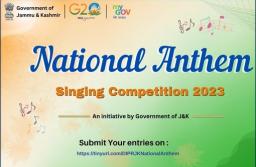The UT of J&K offers beautiful verdant mountains and valleys, religious shrines and remote mountains – a paradise on earth.
The tourism sector is not just a leading source of employment, particularly for women and youth but it also provides opportunities for cohesion and socio-economic inclusion across the regions.
In this regard, J&K MyGov is inviting ideas and suggestions on how to boost tourism in the Union Territory of J&K which will not only encourage tourist inflow but will also support local communities. This would leave a long lasting contribution to strengthen the economy and give new opportunities to the people living here.
Last date of submission is 31st July, 2022.












Farvez Basha D 3 years 4 months ago
In the articles “How Virtual Reality is Transforming the Travel Industry” and “5 Benefits of Virtual Reality Marketing” you find more information about VR marketing and 5 advantages of using virtual reality to increase sales.
Farvez Basha D 3 years 4 months ago
Virtual reality tours can be especially effective as a tourism marketing component, because they allow users to get a sense of what they can expect when they arrive. This can be an especially powerful tool during the booking process, when customers may start to have second thoughts, and when a little extra persuasion can make all the difference.
Farvez Basha D 3 years 4 months ago
Today, virtual reality tours can usually be enjoyed through any of the major web browsers and viewed on a computer, mobile or tablet. The enjoyment can be further enhanced if users have access to a VR headset.
Farvez Basha D 3 years 4 months ago
9. Virtual Reality (VR) Tours
The pandemic has forced businesses to make more intelligent use of tourism technology and virtual reality is one of the most promising areas to explore. This can allow potential customers to experience a hotel, airport lounge, restaurant, local attraction or even certain tourist activities from afar, with no risk.
Farvez Basha D 3 years 4 months ago
In the article “5 Ways Personalisation Marketing Can Benefit the Travel Industry” you can read more detailed information about personalisation marketing within travel.
Farvez Basha D 3 years 4 months ago
. To be effective, personalisation marketing requires you to capture user data and make intelligent use of it, often through AI and automation. This data could be past bookings, web browsing habits, or activity on social media.
Farvez Basha D 3 years 4 months ago
8. Prioritise Personalisation
Modern customers want to be treated as individuals, which is where personalisation marketing comes in. The basic principle is to try to target people with more relevant marketing messages, which appeal to them on an individual level. This could mean, for instance, sending a personalised email, showing them a product they might like. To be effective, personalisation marketing requires you to capture user data and make intelligent use of it, often through AI
Farvez Basha D 3 years 4 months ago
In the article “How Augmented Reality is Revolutionising the Travel Industry” you get a closer look at the impact augmented reality is having on the tourism industry.
Farvez Basha D 3 years 4 months ago
As an example, some tourism apps now allow users to point their phone at a restaurant or tourist attraction in the real world and see online reviews on the screen. Meanwhile, some hotels feature interactive wall maps, which are able to offer significantly more tourist information when viewed through a smartphone.
Farvez Basha D 3 years 4 months ago
7. Utilise Augmented Reality Technology
Although similar to virtual reality, augmented reality is about overlaying digital information onto real-world settings, rather than replacing them with entirely new 3D environments. This can be used for tourism marketing purposes in a number of interesting ways; typically through the use of smartphones and mobile apps.